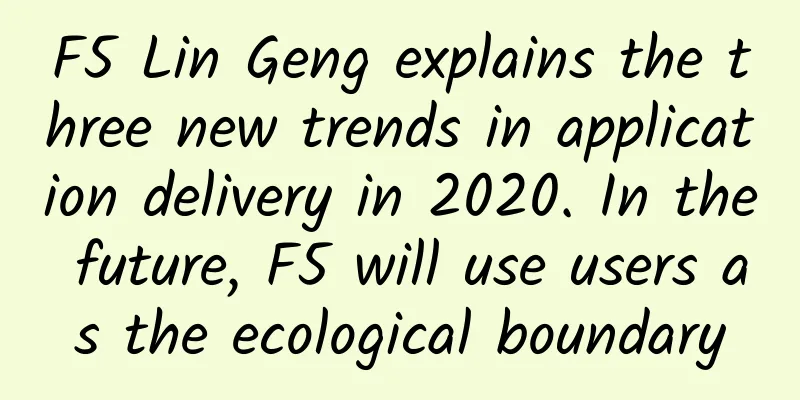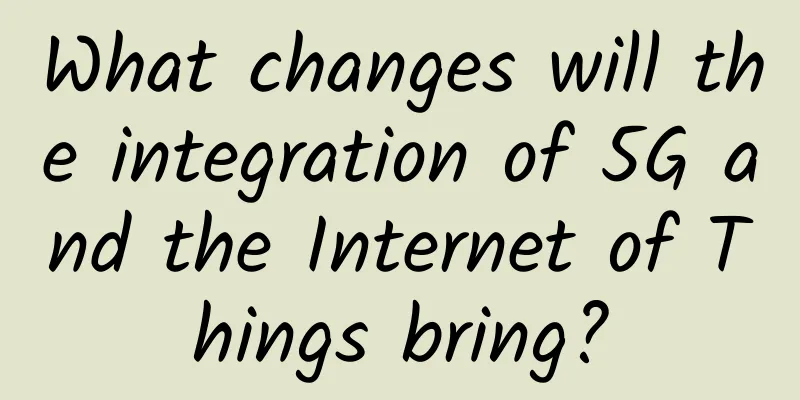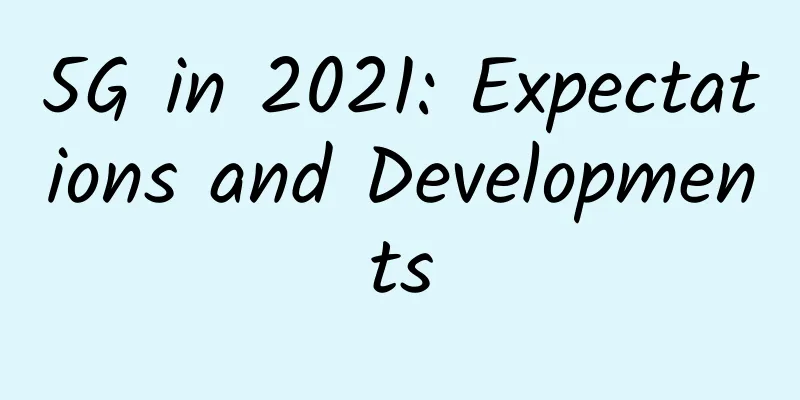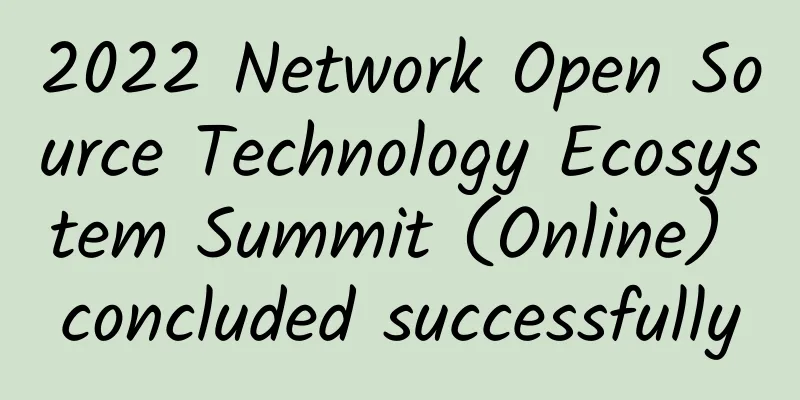F5 Lin Geng explains the three new trends in application delivery in 2020. In the future, F5 will use users as the ecological boundary

|
[51CTO.com original article] At the beginning of January 2020, Lin Geng, who had just joined F5 for half a year, started F5's global "technical cruise". As F5's executive vice president and chief technology officer, Lin Geng chose China as his first stop. When the reporter came to the F5 China headquarters office, Lin Geng was meeting with his colleagues in F5 China, and laughter could be heard from inside the door from time to time. As soon as the meeting ended, the reporter took the opportunity to interview Lin Geng and asked him to talk about his feelings after joining F5 and his plans for future technology directions.
F5 Executive Vice President and Chief Technology Officer Geng Lin F5 will have greater achievements in the future "F5 is a very influential company in the industry, and has been at the forefront of the Internet development as the Internet grows, solving application problems for customers." Lin Geng said that the emergence of applications on the Internet around 2000 provided a paradise for the birth of F5. Later, with the enrichment of Internet applications, more companies began to use cloud-native infrastructure and promote business automation through their own software development. Today, digital transformation has become a consensus among companies, and many customers hope to use the power of artificial intelligence to achieve more "agile" development to meet the needs of rapid business changes. Under such demand, the global distributed application infrastructure layer began to emerge. F5 has a natural development advantage in this field, with relevant cutting-edge technologies and a large user base, which enables seamless entry. Lin Geng said that this is the main reason why he joined F5, and he is confident that he can develop F5 into a global leader in this market with huge potential. He also told reporters that his visit to China was to help the Chinese teams solve technical and customer problems, and to convey F5's latest global strategy, solutions and new directions to the Chinese technical teams and understand the market demand in China. His tight schedule also includes Australia, New Zealand, Singapore and other stops. Three major trends in application delivery in 2020 As F5's chief technology officer, Lin Geng is more concerned about the technological development trends of global application services. He summarized the main trends of change from 2019 to 2020 into three points. The most prominent trend is that the ADC market is becoming more and more software-oriented, which shows that its functions and carriers are gradually separating. "The separation of the two means that F5 can no longer stick to hardware, but can deliver applications anywhere, such as in the cloud or in data center virtual machines." Lin Geng told reporters that in 2019, F5 launched a virtual version of the ADC solution, and the acquisition of NGINX is to achieve a deeper separation of functions and carriers, and ensure the stable delivery of customer applications in different scenarios. Secondly, the boundaries between application delivery, application visualization, and application monitoring are becoming increasingly blurred. Lin Geng believes that this change is related to the faster iteration speed of DevOps. Taking cloud services as an example, in a cloud environment, the work boundaries between the operation and development departments are becoming smaller. F5 can provide many visualized application services to help customers analyze the collected data. This will undoubtedly provide more visualization and monitoring data services while ensuring the stability of application delivery and operation. The last trend is that applications are beginning to transform into business processes. Lin Geng gave an example. In the past, people went to the bank to deposit money, which was a savings business. However, with the popularization of digital devices, people can realize self-service deposits, withdrawals, life payment and other services at ATMs. These services have actually become applications provided by banks for depositors. "The performance of the application itself is no longer limited to the technical level, but releases more and more business-level signals." Lin Geng believes that F5 can collect these signals, make accurate feedback through the analysis of various data, and deploy more complete customer services. Taking banks as an example, F5 can use technical means to gain insight into which bank transactions are abnormal, which performance is unevenly distributed, and which applications are more popular, and then feedback to the bank to assist in decision-making. After seeing these changes in the application delivery field, Lin Geng will lead F5's technical team to make greater strategic adjustments in 2020. He revealed that he has formulated a three-stage development strategy: in the first stage, together with NGINX, the functions and carriers of application delivery will be separated more deeply; in the second stage, F5 will use its natural advantage in the entry point between applications and users to reach more application traffic, conduct deeper telemetry and analysis, gain insights into the positive feedback to user business services, and thus deliver some new business optimization services; in the third stage, F5 will further strengthen application security protection, do advanced application security, and ensure that users' applications are stable and reliable. From code to users, with users as the ecological boundary When asked about the differences between Chinese customers and customers in developed countries in the digital transformation stage, Lin Geng believes that there are still many similarities between the two sides. Taking financial customers as an example, Chinese banks and banks in developed countries are both relatively large in scale, are the vanguards of digital transformation, and have similar development paths. The difference lies in the different regulatory policies of different countries, such as which data can be placed in the public cloud, and the risk control decisions are also different. F5 recently proposed the concept of "code to user". Lin Geng explained that in digital enterprises, "code" reflects the business process, and the speed of change of "code to user" represents business agility. In this new era of digital economy, applications have become the lifeblood of the global economy. Every enterprise will gradually become an application enterprise, and every industry is becoming an application-centric industry. In the future, F5 will build an ecosystem based on its own size and influence, and ultimately it will still focus on users and solve user pain points. "This is the boundary of our ecosystem." [51CTO original article, please indicate the original author and source as 51CTO.com when reprinting on partner sites] |
<<: NB-IoT smart door magnet market stimulated by the epidemic
>>: F5 Releases Next-Generation NGINX Controller 3.0 to Accelerate Modern Application Delivery
Recommend
The core technical principles behind DingTalk document collaborative editing
Some people say that the most profound change tha...
DigitalVirt: Los Angeles AS9929 line starting at 39 yuan/month, 1GB/20G NVMe/1TB monthly traffic
DigitalVirt is a Chinese hosting company founded ...
Related steps of network construction and problem solving
The basic process of network construction include...
5G, how is the construction going?
Nowadays, everyone knows about 5G. 5G has taken o...
Riding the sail of open source, taking advantage of the official certification exam, stand out in the NGINX field
[Original article from 51CTO.com] Since the offic...
EasyVM: $3/month KVM-2GB/30GB/2TB/Dallas & New York, etc.
EasyVM is a foreign hosting company founded in 20...
A review of SDWAN's martial arts schools in 2018
There is no shortage of newcomers in the network ...
New enterprise video conferencing strategies must go beyond meetings
Today’s workflows are increasingly digital, and v...
5G: The era of “oligopoly” operators ends, and the era of cross-border “group fights” begins
If you establish a mapping relationship between I...
Is the cost of building enterprise campus networks high? Ruijie's simplified Ethernet all-optical network provides a "good solution" to solve the problem
Digital transformation is being used as a powerfu...
What comes after 5G communications?
This topic seems a bit paradoxical. First of all,...
Ethernet VS PON network: Which one is more suitable for enterprise campuses?
The trend of optical fiber replacing copper fiber...
Bricklayer Los Angeles CN2 GIA (DC6)/Japan Softbank special price $46.6/year
[Restocked again on 10.15] Bandwagonhost has launc...
ProfitServer Netherlands VPS 50% off, unlimited traffic VPS monthly payment starts from $2.88
ProfitServer is a Russian hosting company founded...
Virtono: $24.9/year KVM-1GB/30GB/2TB/Japan & Singapore & Hong Kong, China, etc.
Virtono recently launched a new promotion on LET,...









